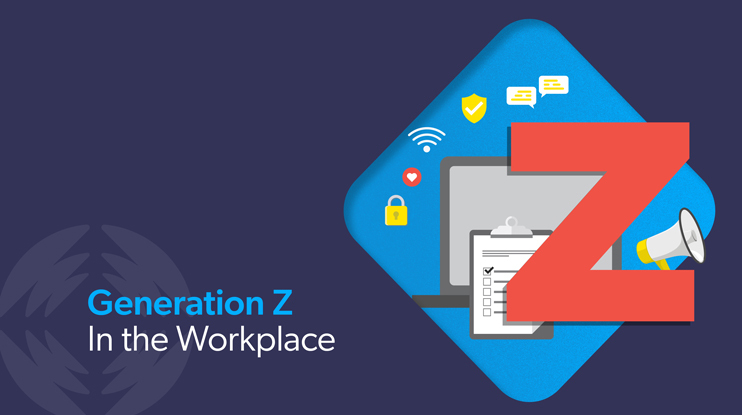The past few years have seen an increasing digital transformation of the workplace with the normalization of things like AI and the mass shift to remote work. But the real pressure to modernize is coming from the younger generation of workers: Gen Z.
This demographic is set to outnumber Baby Boomers in the workforce by the end of 2024. As their presence grows, it’s important to understand that these young professionals have very different expectations than that of the baby boomers, Generation X, and millennials that preceded them.
Generation Z is known for being motivated by social impact, prioritizing work-life balance, and being technologically savvier than any other generation. They are often referred to as “digital natives” (or even “digital wizards”), being the only generation to have truly grown up with technology like smartphones.
Understanding Gen Z in the workplace requires understanding their digital expectations. Their day-to-day digital experiences, from shopping habits to social media, are hyper-personalized and ultra-efficient. In the workplace, Gen Z employees will want to operate at this same level of digital sophistication.
What Does Generation Z Expect in the Workplace?
Here are the Generation Z expectations that you can meet by using an AI-powered relevance platform to streamline internal communication and workplace learning.
Continuous evolution
While many in previous generations preferred things to be stable and familiar, Gen Z is used to and expects rapid change and continuous improvement in the way things are done, particularly in technology.
These digital natives expect the latest and most advanced tools. In fact, according to research done by Adobe, 70% of Gen Zers would switch jobs for better technology. Young employees are so inundated with technological advancements (like a new and improved iPhone made available every few years) that they barely even see it as evolution; it’s just the way things are expected to work.
Business leaders are becoming more and more aware of the value of evolving technology in the workplace. So much so that 91% of decision-makers are saying they recognize the need to provide more advanced digital experiences to meet the needs of Gen Z employees, conscious of the imperative to retain emerging young talent in the workplace.
Fast progress
According to a recent Business Insider article that combines numerous Gen Z interviews and studies, Gen Z is extremely motivated by career development and advancement, and will move on to other opportunities if they don’t get it.
To satisfy the Gen Z desire to quickly move up in the workplace, an employer must provide rewarding learning experiences that have a clear connection to career growth. If companies fail to do this, they’ll likely start seeing their youngest workers move on to employers who will.

Self-service
This is the generation that grew up learning from YouTube tutorials. They’re used to efficient, self-paced, self-service learning, and, when it comes to taking on a new role, they want the same.
Gen Z individuals feel most comfortable with easy-to-consume digital instructions and the more formal, in-person training many older generations are comfortable with makes less sense for these young people.
Businesses need to be able to teach and transfer relevant skills with succinct, on-demand, micro-learnings that offer self-served information and at-your-fingertips progress.
Sophisticated user experiences
Gen Zers spend a lot of time on their phones, making them extremely accustomed to sleek, fast, and intuitive interfaces. To thrive at work, Gen Z needs to be able to easily navigate the digital workplace and feel like the technology is assisting them, not making things harder.
Legacy 90s intranets and other outdated software will have every Gen Zer running toward the exit door, but the right AI-powered platform can transform your employees’ digital experience.
Employers can entice employee engagement from this new generation by transferring their heightened UX expectations to their workplace intranets and company culture. And if they do, employees of all generations will benefit, not just Gen Z.
Relevant Reading: Intranet Best Practices https://www.coveo.com/blog/intranet-best-practices/
Personalization
This is a generation that has grown up with ultra-personalized digital experiences. They get it from every digital space they enter – Google, Netflix, Amazon, Instagram, TikTok, etc. – and the technology at work should serve them no differently.
Enterprises with clunky intranets and siloed information make resources very challenging to find in the digital realm. This comes across as painfully behind the curve and out of touch with Generation Z workers.
For a real-world example, Comcast partnered with Rightpoint and Coveo to futureproof their intranet. The new intranet launched with a monthly adoption rate of 93%, far exceeding industry standards. Even more remarkable, the search success rate held steady at 80-81% after migration, despite the team’s initial concerns about potential drops in performance.
Flexible Schedules
For almost all Gen Z workers, remote work was their first employment experience. They can’t imagine anything different now.
Even over remote work though, young workers seem to be drawn to the hybrid work structure more than any previous generation. They likely won’t even consider applying for roles that are 100% in-office with rigid schedules and structured in-person expectations.
Companies looking to attract and retain top Gen Z talent would be wise to work flexibility into their culture to promote work life balance.

How Can Companies Create a Digital Workplace That’s Fit for Gen Z Workers?
Here are a few ways to foster Gen Z-friendly digital workplaces:
Personalize the workplace with artificial intelligence (AI).
Only AI can provide the kind of one-to-one personalization Gen Z is used to, at scale. Enterprises can provide more sophisticated experiences for their Gen Z workforce by using AI-powered search to learn about their user intent on digital work platforms. This will help deliver the kind of tailored knowledge experiences Gen Z is accustomed to everywhere else.
Offer asynchronous collaboration to support flexible schedules.
Companies can now bring knowledge to the modern communication tools they use, such as Slack. When AI is used within these tools, it powers more effective collaboration, especially in a hybrid workplace with teams often working at a distance and in different time zones.
Create knowledge management initiatives to enable self-service from anywhere.
From hiring to onboarding to professional development, companies can help Gen Z employees excel and grow in their roles on their own terms. A key tactic is to offer hiring and training materials, achievement expectations, and learning goals in a centralized location like an intranet or self-service portal. This empowers these young workers to learn, grow, and meet expectations for progress at work.
Provide a user experience that meets expectations.
Employees shouldn’t have to waste their work hours searching high and low for the information they need to do their job. In our EX Industry Report for 2024, more than a third of employees (34%) said not having the right tools makes them feel frustrated or burnt out.

To set Gen Z up for success, companies should prioritize making it easy for them to find what they need through AI-powered content recommendations, query suggestions, and other meaningful personalizations across digital platforms.
Create consistent experiences at every touchpoint.
Gen Z is used to seamless integrations between social networks, communication apps, and even things like personal finance and digital banking. Their digital platforms interact and communicate with each other to provide a better, simpler overall experience.
Employers must connect their digital workplace in the same way, providing a familiar, efficient experience at every touchpoint of the employee experience.
Are You Ready for Gen Z?
Here’s the takeaway: Generation Z will soon make up a large portion of the workplace, and if enterprises want to effectively hire, train, and retain Gen Z talent, they’ll need to offer up-to-date, personalized, and responsive digital experiences at work.
Employees are looking for better prospects en masse. To create a digital workplace that attracts and retains talent, employers have to understand that AI-powered search is the throughline of the modern virtual office.
Dig Deeper
Employees are looking for better prospects en masse. To create a digital workplace that attracts and retains talent, employers have to understand that search is the throughline of the modern virtual office.
We dig into all the ways you can do this, using AI-powered search, in our ebook, Guide to Delivering AI-Powered Employee Experiences.


